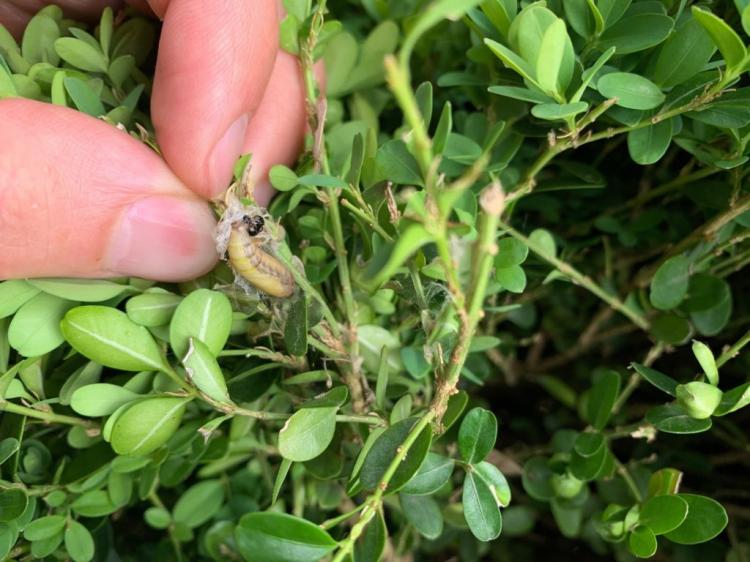
Boxwood Bugs + Fungus
Boxwood Problems in Niagara
Yes, unfortunately, it’s true! Boxwoods in Niagara have been having a hard time over the past few years and are being hit with multiple issues including caterpillars (likely from the boxtree moth), leaf minors and blight. Make sure you know what is affecting your boxwood so you can execute the correct treatment plan!
Boxtree Moth
The boxtree moth has been an invasive species in the Niagara region since 2020. The moth itself is quite large, with a wingspan of 4.5cm. You may have noticed the identifying dead leaves, dead branches and white webbing on your boxwood shrubs already. The caterpillars will also show up to prove that you have a boxtree moth situation. If you check underneath the leaf, you are likely to find some yellowish eggs that have been laid to multiply your problem!

Let’s hope that you were able to catch your infestation early enough! If your boxwood has already been irreversibly damaged by the box tree caterpillars, you may not be able to save your boxwood tree. But don’t give up hope just yet! The best solution that we have been seeing here at the greenhouse is to give your boxwood a good, hard prune. Try your best to cut back ⅓ of the boxwood shrub. Once it’s cut back and all of the offending material has been removed or burned, you’re ready for the insecticide application. Come on down to the garden centre to pick up a bottle of BTK. This is a concentrated biological insecticide made by Safer’s and is suitable for killing the catepillar stage of the boxtree moth. You’ll want to spray your plant during the egg and pupae and caterpillar stages to be able to rid yourself of any of the caterpillars that will find themselves hungry for boxwood!
Blight
The fungus that causes boxwood blight can infect all aboveground portions of the shrub. Symptoms begin as dark leaf spots that coalesce to form brown blotches.

The undersides of infected leaves will show white sporulation of the boxwood blight
This fungus does not attack the roots of the plant, but it can cause some defoliation. If the plant lose its foliage and has severe die back year after year, it could kill the shrub. Losing their leaves can make them look a lot less attractive in the garden, so it’s your choice if you want to attempt to cure or replace your boxwoods. Always be careful when introducing a new plant into an existing garden, particularly with boxwoods. You don’t want a new plant with a fungus problem to affect your other, more mature boxwoods. When you prune the boxwood, make sure to burn or completely remove the cut off stems so that they do not reinfect surrounding plants. Once pruned, you will want to spray the plant with a fungicide. Choose a product like lime sulphur, 3 in 1 garden spray or neem oil or anything that is labelled as a fungicide. Follow application instructions on the bottle.
Leaf Miner
The boxwood Leafminer can cause massive devastation to boxwoods. Though, it’s technically not a leafminer, but a midge, this pest causes blisters and defoliation that can be quite an eyesore for a boxwood enthusiast. Over a period of several years, a lightly infested plant can become discolored, yellowish-brown, and even defoliate. In rare occasions, severe Boxwood Leafminer populations can kill boxwood. The good news about Boxwood Leafminer is that there are effective control options and those options are simple because there is only one generation of the pest per year.

Active infestations appear as puffy blisters with an orange-ish tint on the bottoms of the leaves and pale light green or yellow speckles on the upper leaf surface.
Later in the growing season, damaged leaves turn brown on the top and bottom, and may even drop from the plant in large quantities.
Boxwood leafminer larvae, on the other hand, are seldom seen by gardeners – unless you know what to look for and are willing to peel apart a leaf. The larvae are miniscule (3 mm) yellow to orange maggots that spend their whole larval life-stage inside of a single leaf. Sometimes these larval miners live by themselves in a leaf, but there can be up to 8 maggots sharing a single leaf. If you suspect an infestation, peel open a leaf in the early spring and you’ll see the maggots inside (see photo below).
Prune your boxwood in early spring to help eliminate some of the leaves that have become hosts for the larvae of the midge. Make sure to clean your pruners before moving on to the next plant to avoid transferring anything from shrub to shrub. Then, give it a good spray with Neem Oil - an all natural insecticide! See the recipe in store to learn how to mix and spray this particular product!

